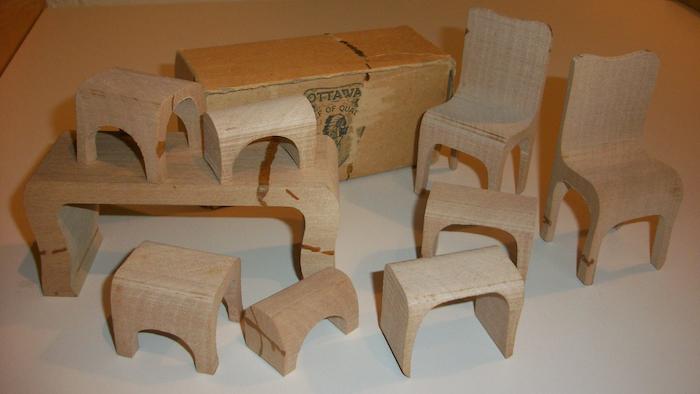puzzle
Catalog Number
2018.20.13a-jDescription
Wooden puzzle consisting of 9 pieces of furniture. The box is tan, cardboard (lid is loose) and contains the Ottawa Furniture Company logo.History
The following history of the Ottawa Furniture Company is from Robert Swierenga's book "Holland Michigan: From Dutch Colony To Dynamic City", pages 881-884"Reinder E. “Ryn” Werkman was a prime mover in the first major furniture factory, Ottawa Furniture Co., which developed out of his factory on River Street. Werkman in 1888 began making furniture and cabinets with a workforce of eight men in leased space at the Phoenix Planing Mill. In 1887 he enlisted Hendrik “Heine” Te Roller, founder in 1880 of the Te Roller Manufacturing Co., creamery owner Matthew Notier, and Cornelius J. De Roo of the Standard Rolling Mills to join him in forming the Werkman Furniture Company. The object was to produce inexpensive furniture in the facilities of his Werkman Manufacturing Co., which had failed to thrive. His partner Abel Brink gladly sold his interest to the group. The three-story factory on River Avenue about Fifth Street went into production early in 1888 with from sixty to seventy workers, and the first successful product was a bird’seye maple bedroom suite priced at only fourteen dollars (see chapter 12 for more details about Werkman’s enterprises).11 A few years later, Werkman went bankrupt because of a faulty title on the property. Builder James Huntley, brother of the city’s electricity pioneer, rescued the company with a large cash infusion and took over as manager. In 1891 an investment group of Jacob “Black Jake” Van Putten, Barteld “Bert” Slag, Cornelius Blom Sr., Cornelius Ver Schure, and several members of the Huntley and Herman Van Ark families, including Gradus Van Ark, put up $32,000 in capital, bought out Werkman’s interest, and formed the Ottawa Furniture Company.12 Huntley’s health failed within a year, and George W. Browning became manager; he enjoyed much success until his death in 1913. Ottawa Furniture paid a regular stock dividend of 10 percent, and its owners increased their paid-in capital to the authorized limit of $100,000.
William Wing succeeded Browning and ran the factory until 1920, and Arthur Visscher followed him as president and general manager. Over the years, the firm targeted the medium-priced market, turning out dining room and bedroom sets, and breakfast and apartment suites under $1,000. The workforce increased gradually from eighty-five to two hundred, and the company practiced profit sharing. For the year 1915 the company distributed $1,500 in cash to the workers. In the mid-1920s, after a large addition, Ottawa Furniture occupied a threestory factory and an adjacent two-story warehouse, both served by a Chicago & West Michigan Railway siding.13 The firm marketed more than a million dollars’ worth of furniture nationally under the slogan “Chief of Quality,” with a sales force of twenty men. “Is it any wonder that where living conditions are ideal, labor is contented, and no strikes occur, workmanship is of the best?” declared a company brochure, which touted its “old time Dutch cabinet makers.” To display its products, the company in 1928 opened a threestory retail store next door to the factory. Skylights helped illuminate the third-floor merchandise. Only eighteen months after the auspicious store opening, the stock market crash of 1929 put a crimp in furniture sales, which consumers viewed largely as discretionary. In January 1930 Ottawa Furniture went into “friendly receivership.” Three years later, in December 1933, the buildings were razed, leaving an empty lot for years. Holland’s first major furniture company fell victim to the terrible depression that hit that industry especially hard.".
